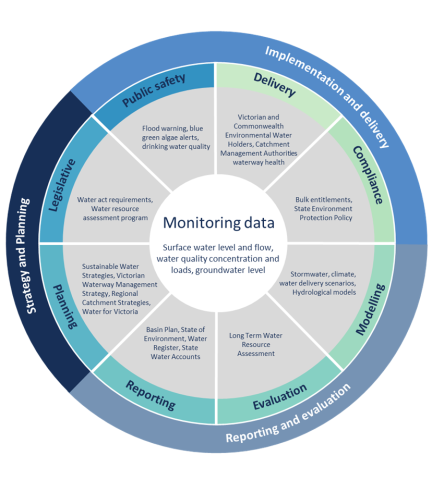
Many organisations undertake water monitoring for a variety of purposes. The below diagram shows the uses that water monitoring supports, namely:
- strategy and planning planning
- planning - Sustainable Water Strategies, Victorian Waterway Management Strategy, Regional Catchment Strategies, and Water for Victoria
- legislative - Water act requirements, and water resource assessment program
- implementation and delivery
- delivery - Victorian and Commonwealth Environmental Water Holders, Catchment Management Authorities, waterway health
- compliance - Bulk entitlements, Environmental Reference Standards, (supersedes State Environment Protection Policy)
- reporting and evaluation
- modelling - stormwater, climate, water delivery scenarios, and hydrological models
- evaluation - long-term water resource assessment
- reporting - Basin Plan, State of Environment, Water Register, State Water Accounts
Not all water monitoring happens as part of the Regional Water Monitoring Partnership (RWMP).
Listed below are some of the water monitoring programs that are not part of the RWMP:
Yarra watch and Beach Report
Melbourne Water and EPA undertake Yarra Watch which reports:
- on water quality at 4 locations in the Yarra River Yarra and
- Beach watch summer water which reports on water pollution (E.coli) and provide water quality forecasts at 36 Melbourne beaches during the summer months.
Drinking water quality
The Department of Health and Human Services oversees the monitoring and reporting on drinking water quality by water corporations to ensure that they meet drinking water quality standards. Each water corporation produces an annual report on drinking water quality. These reports are available on their individual websites.
Citizen science
There are two long running citizen science monitoring programs in Victoria:
Waterwatch Victoria is a community engagement program connecting local communities with river health and sustainable water issues and management since 1993 Waterwatch .
EstuaryWatch is another citizen science program that supports community members to participate in the monitoring of estuary health .
Rainfall
The Bureau of Meteorology (BOM) has 536 rainfall stations across of the state. Data for these sites is found on the BOM water data online portal and Victoria Rainfall and River . There are 275 active sites which record rainfall as part of the RWMP.
Storage water levels
All the major water corporations report on storage levels in their area. This information can be found on the water corporation web sites. This information is summarised weekly by DEECA Current water and contains links to the water corporation websites.
Blue green algae
Water corporations provide warnings and public alerts on presence of high levels of blue green algae. Examples are:
Goulburn Murray Water website news
Grampians Wimmera Mallee Water website rec algae
Blue green algae levels are used to inform the public on the:
- safety of the water for recreational activities, including swimming and boating, and
- for possible impacts on stock and animals.
Further surface water monitoring
Some of the larger RWMP partners have separate monitoring program in addition to the partnerships. Partners with separate monitoring programs include Melbourne Water, Goulburn Murray Water and Southern Rural Water.
Melbourne Waters river monitoring network - rainfall and river .
Reviewed 14 June 2024
